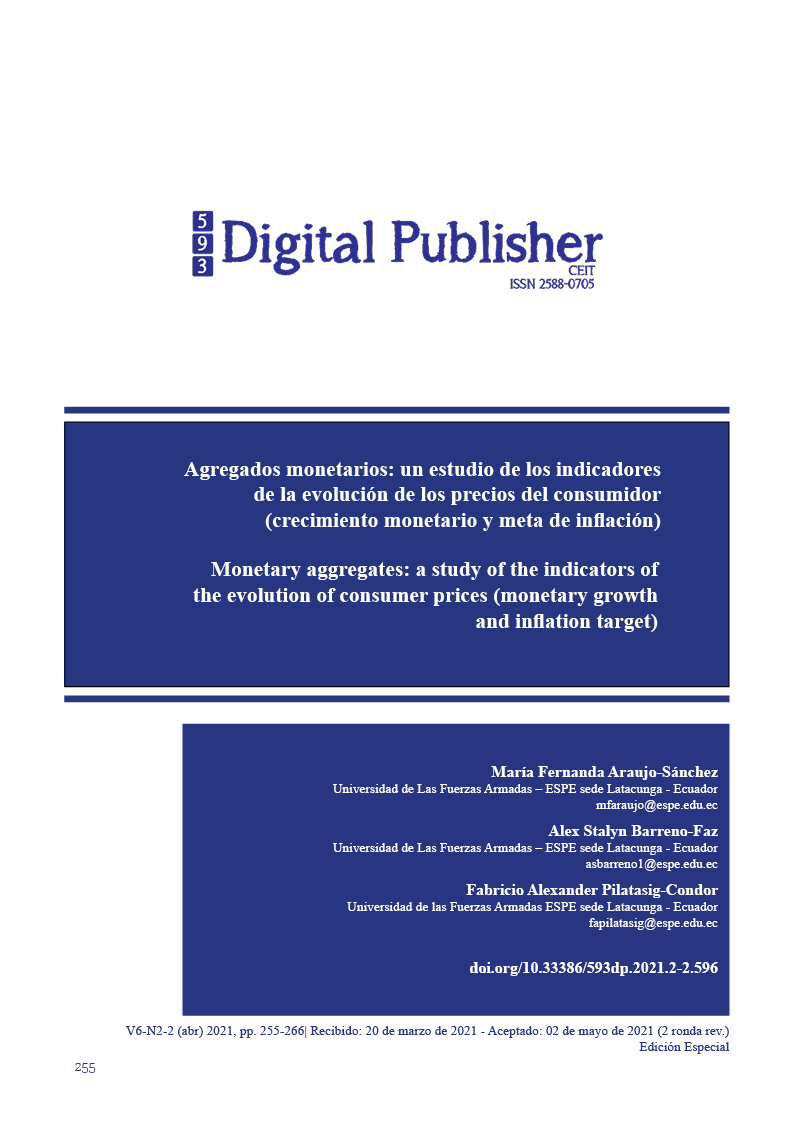Monetary aggregates: A study of the indicators of the evolution of consumer prices (monetary growth and inflation target)
Main Article Content
Abstract
The Consumer Price Index allows the interpretation of inflation through the calculation of the annual variation of prices, however, the problem in making such calculation lies in the difficulty of collecting information on the relative prices of goods and services, which causes distortion together with inconsistencies in the application of the calculator index. The objective of the research was to analyze the monetary aggregates through their two main components M1 (money supply) and M2 (total liquidity) and their relationship with inflation behavior. The methodology applied took a quantitative approach, since a linear correlation econometric model was used with annual data from 2007 to 2020. The main result obtained shows that there is endogeneity between money supply and inflation, which means that it is possible to consider monetary aggregates for monetary policy decisions.
Downloads
Article Details

This work is licensed under a Creative Commons Attribution-NonCommercial-ShareAlike 4.0 International License.
1. Derechos de autor
Las obras que se publican en 593 Digital Publisher CEIT están sujetas a los siguientes términos:
1.1. 593 Digital Publisher CEIT, conserva los derechos patrimoniales (copyright) de las obras publicadas, favorece y permite la reutilización de las mismas bajo la licencia Licencia Creative Commons 4.0 de Reconocimiento-NoComercial-CompartirIgual 4.0, por lo cual se pueden copiar, usar, difundir, transmitir y exponer públicamente, siempre que:
1.1.a. Se cite la autoría y fuente original de su publicación (revista, editorial, URL).
1.1.b. No se usen para fines comerciales u onerosos.
1.1.c. Se mencione la existencia y especificaciones de esta licencia de uso.
References
Alvarez, R. (2020). Clasificación de las Investigaciones (Nota académica). Universidad de Lima, Perú.
Banco Central del Ecuador. (2020). Información monetaria Oferta monetaria M1 y Liquidez total M2. Ecuador. Obtenido de https://contenido.bce.fin.ec/documentos/Administracion/bi_menuBoletin.html
Barros, E. (2015). La meta de inflación como esquema monetario. Revista de Ciencias Sociales, 44(2), 223-250.
Cueva, G. (2017). Análisis conceptual de los Títulos del Banco Central para el reciclaje de liquidez (Disertación de economía). Universidad Católica del Ecuador, Ecuador.
De Gregorio, J. (2003). Dinero e Inflaciòn (Documento de trabajo). Banco Central de Chile.
Flores, A. (2017). Medios de pago y cambio en dolarización oficial en el Ecuador (Disertación de economía). Universidad Central del Ecuador, Ecuador.
Friedman, 1. (1970). Teoria Monetariata de la Inflación. ResGet Vol. IX, 18. Obtenido de https://biblio.flacsoandes.edu.ec/catalog/resGet.php?resId=11563
Garda, P., Lanzilotta, B., & Montero, R. (2006). Agregados Monetarios e Inflación en Uruguay ¿Una relación no lineal? CINVE ISSN: 1688-6186, 1(1), 3-26.
Hernández, R. (2017). Metodología de la investigación (Vol. Sexta edición). (I. 978-1-4562-2396-0, Ed.) México: McGRAW-HILL / INTERAMERICANA EDITORES, S.A. DE C.V. Obtenido de https://www.uca.ac.cr/wp-content/uploads/2017/10/Investigacion.pdf
Instituto Nacional de Estadística y Censos. (2021). Historicos del Indice de Precios al Consumidor . Ecuador en cifras . Quito, Ecuador. Obtenido de https://www.ecuadorencifras.gob.ec/historicos-ipc/
López, P., & Fachelli, S. (2015). Metodología de la investigación social cuantitativa (Vol. 1). España: Creative Commons.
Otzen, T., & Manterola, C. (2017). Técnicas de muestreo sobre una población a estudio. ScIELO, 227 - 232. Obtenido de https://scielo.conicyt.cl/pdf/ijmorphol/v35n1/art37.pdf
Pontón, R. (Febrero de 2013). Los agregados monetarios y la inflacion. Bolsa de Comersio de Rosario, 2. Rosario, Argentina: N° Edición 1598.
Pozo, A., & Cárdenas, D. (2020). Endogeneidad monetaria en una economía dolarizada; Caso Ecuador. Revista Economía, 72(115), 33 - 49.
Ramos, M. (2017). Uso de agregados monetarios como indicadores de la evolución futura de los precios al consumidor: crecimiento monetario y meta de inflación. El trimestre económico, 1(33), 5-70.
Robles, M. (2020). Inflación en los precios reales de los alimentos. Organización de las Naciones Unidas para la Alimentación y la Agricultura.
Rojas, M. (2015). Tipos de Investigación científica: Una simplificación de la complicada incoherente nomenclatura y clasificación. REDVET ISSN 1695-7504, 16(1), 1 - 14.
Sánchez, G., & Cruz, I. (2019). Crecimiento económico e inflación, determinantes del desempleo en Ecuador. Espacios ISSN 0798 1015, 40(37), 1 - 11.
Sánchez, H., Reyes, C., & Mejía, K. (2018). Manual de términos en investigación científica, tecnológica y humanística. Universidad Ricardo Palma, 1, 81 - 146.
Tene, E. (2020). Evolución de la inflación en el Ecuador durante el periodo 2016 - 2019 (Disertación de postgrado). Universidad Técnica Particular de Loja, Ecuador.
Valle , A., Salguero, M., & Salgado, M. (2015). Análisis de los Agregados monetarios M1 y M2 como objetivo de la Politica monetaria (Nota técnica). Banco Central del Ecuador, Ecuador.
Vera, C., & Tenesaca, F. (2020). Índice de Precios al Consumidor. Boletín técnico N° 01-2020-IPC, Instituto Nacional de Estadística y Censo, Ecuador.
Vera, L. (2009). El control de los agregados monetarios: lecciones y experiencias del caso venezolano reciente. Economia e Sociedade, Campinas,, 18(35), 141-181.
Villalba, M. (2019). Dolarización: dos décadas después. (E. A. Yala, Ed.) Serie Economía y Territorio ISBN: 9789942096616, 1, 7 - 228.
Zambrano, M. P. (2010). Incidencia de la oferta monetaria en la inflación de economías dolarizadas. Caso ecuatoriano, 2007-2010. Quito, Ecuador.




